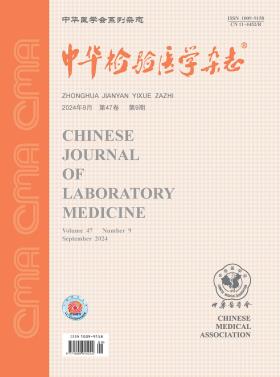Interfering effect of maternal cell contamination on invasive prenatal chromosome microarray analysis
Q4 Health Professions
引用次数: 0
Abstract
Objective To access the effect of maternal cell contamination (MCC) on the detection of copy number variation (CNV) by chromosome microarray analysis (CMA) in prenatal diagnostic samples. Methods Amniotic fluid DNA samples were collected from Department of Prenatal Diagnosis (Screening) Centre of Hangzhou Women′s Hospital from December 2016 to August 2018. Copy number variations (CNVs) were identified in these DNA samples by CMA and normal female genomic DNA was added to simulate different proportions of maternal cells contamination. The simulated samples were tested using an Agilent microarray chromosome chip 180K CGH (Agilent 180K CGH) and the results were analyzed by Agilent CytoGenomics software. Results The results showed that duplications of CNV could not be detected at>38.4% MCC. Deletions of CNV could not be detected at>41.3% of MCC. With the increase of MCC ratio, the detection rate of CNV decreased gradually. The array and software allowed detection of longer copy-number variations at higher levels of maternal cell contamination than shorter copy-number variations. For the same size CNV, the detection ability of the deleted CNV was slightly higher than that of duplication. In the male sample, the observable shift of the X/Y chromosome ratio at>10% MCC can be detected by the microarray. Conclusions When the MCC is higher than a particular ratio, it can affect the CMA detection of CNV. Based on the Agilent 180K CGH detection results for MCC mimics and the CNV detection specificity principle, the MCC threshold of the Agilent 180K CGH is set to 30% in view of conservative principles. Key words: Amniotic fluid; Prenatal diagnosis; Microarray analysis; DNA copy number variations母体细胞污染对侵入性产前染色体微阵列分析的干扰作用
目的探讨母体细胞污染(MCC)对产前诊断样本染色体微阵列分析(CMA)检测拷贝数变异(CNV)的影响。方法于2016年12月至2018年8月在杭州市妇产医院产前诊断(筛查)中心采集羊水DNA样本。通过CMA鉴定这些DNA样本的拷贝数变异(CNVs),并添加正常女性基因组DNA来模拟不同比例的母细胞污染。模拟样本使用安捷伦180K CGH微阵列染色体芯片(Agilent 180K CGH)进行检测,并通过Agilent CytoGenomics软件对结果进行分析。结果在>38.4%的MCC中未检出重复的CNV。在>41.3%的MCC中未检测到CNV的缺失。随着MCC比值的增加,CNV的检出率逐渐降低。该阵列和软件允许在较高水平的母体细胞污染下检测较长的拷贝数变异,而不是较短的拷贝数变异。对于相同大小的CNV,删除的CNV的检测能力略高于重复的检测能力。在男性样本中,可以通过微阵列检测到>10% MCC时X/Y染色体比例的明显变化。结论当MCC高于一定比例时,会影响CNV的CMA检测。基于Agilent 180K CGH对MCC模拟物的检测结果和CNV检测特异性原则,考虑到保守原则,将Agilent 180K CGH的MCC阈值设置为30%。关键词:羊水;产前诊断;微阵列分析;DNA拷贝数变异
本文章由计算机程序翻译,如有差异,请以英文原文为准。
求助全文
约1分钟内获得全文
求助全文
来源期刊

中华检验医学杂志
Health Professions-Medical Laboratory Technology
CiteScore
0.40
自引率
0.00%
发文量
8037
期刊介绍:
 求助内容:
求助内容: 应助结果提醒方式:
应助结果提醒方式:


